- Home
- Carl Sagan
Broca's Brain Page 28
Broca's Brain Read online
Page 28
CHAPTER 19
EXPERIMENTS
IN SPACE
We ever long for visions of beauty,
We ever dream of unknown worlds.
MAXIM GORKY
UNTIL RELATIVELY recently, astronomy suffered from a serious impediment and remarkable peculiarity: it was the only thoroughly nonexperimental science. The materials of study were all up there, and we and our machines were all down here.
No other science was so severely constrained. In physics and chemistry, of course, all is forged on the anvil of experiment, and those who doubt a given conclusion are free to perform a wide range of alternative manipulations of matter and energy in an attempt to extract contradictions or alternative explanations. Evolutionary biologists, even those of very patient temperaments, cannot afford to wait a few million years to observe one species evolve into another. But experiments on common amino acid sequences, enzyme structure, nucleic acid codes, chromosomal banding, and anatomy, physiology and behavior make a compelling case for the fact that evolution has occurred and clearly show which plant or animal groups (such as human beings) are related to which others (such as the great apes).
It is true that geophysicists, studying the deep interior of the Earth, cannot travel to the Wiechert discontinuity between core and mantle, or (just yet) to the Mohorovicic discontinuity between mantle and crust. But batholiths, extruded from the deep interior, can be found here and there on the surface and examined. The geophysicists have relied largely on seismic data, and here, like astronomers, they could not force the favors of nature but were compelled to await their voluntary bestowal—for example, in a seismic event situated on the other side of the Earth so that one of two nearby seismometers would be in the shadow of the Earth’s core and the other not. But impatient seismologists can and have set off their own chemical and nuclear explosions to ring Earth like a bell. And there are intriguing recent hints that it may be possible to turn earthquakes on and off. Those geologists intolerant of inferential reasoning could always go to the field and examine contemporary erosion processes. But there was no exact astronomical equivalent of the hard-rock geologist.
We have been restricted to the electromagnetic radiation reflected and emitted by astronomical objects. We have not been able to examine pieces of stars or planets* in our laboratories or to fly into such objects to examine them in situ. Ground-based passive observations have restricted us to a narrow fraction of the conceivable data on astronomical objects. Our position has been much worse than that of the fabled six blind men in pursuit of the nature of the elephant. It has been more like one blind man in a zoo. We were standing there for centuries stroking a left hind foot. It is not surprising that we did not deduce tusks, or notice that the foot did not belong to an elephant at all. If, by accident, the orbital plane of the double star was in our line of sight, we would see eclipses; otherwise not. We could not move to a position in space from which the eclipses could be observed. If we were observing a galaxy when a supernova was exploding, we could examine the supernova spectrum; otherwise not. We do not have the ability to perform experiments on supernova explosions—which is just as well. We could not examine in the laboratory the electrical, thermal, mineralogical and organic chemical properties of the lunar surface. We were restricted to inferences from the visible light reflected and the infrared and radio waves emitted by the moon, aided by occasional natural experiments such as eclipses and lunations.
But all that is gradually changing. Ground-based astronomers have, at least for nearby objects, an experimental tool: radar astronomy. At our convenience, at our choice of frequency, polarization, bandpass and pulse length, we can irradiate a nearby moon or planet with microwaves and examine the returned signal. We can wait for the object to rotate underneath the beam and illuminate some other place on its surface. Radar astronomy has delivered a host of new conclusions on the rotation periods of Venus and Mercury, and related problems in the tidal evolution of the solar system, on the craters of Venus, the fragmented surface of the Moon, the elevations of Mars, and the size and composition of the particles in the rings of Saturn. And radar astronomy is just beginning. We are still restricted to low altitudes, and for the outer solar system, to sun-facing hemispheres. But with the newly resurfaced Arecibo telescope of the National Astronomy and Ionosphere Center in Puerto Rico, we will be able to map the surface of Venus to a resolution of 1 kilometer—better than the best ground-based photographic resolution of the lunar surface—and obtain a host of new information on the asteroids, the Galilean satellites of Jupiter and the rings of Saturn. For the first time we are poking around in cosmic stuff, electromagnetically fingering the solar system.
A much more powerful technique of experimental (as opposed to observational) astronomy is spacecraft exploration. We can now travel into the magneto-spheres and atmospheres of the planets. We can land on and rove over their surfaces. We can collect material directly from the interplanetary medium. Our first preliminary steps into space have shown us a wide range of phenomena we never knew existed: the Van Allen trapped-particle belts of the earth; the mass concentrations beneath the circular maria of the moon; the sinuous channels and great volcanoes of Mars; the cratered surfaces of Phobos and Deimos. But what I am most struck by is that, before the advent of space vehicles, astronomers did very well—hamstrung though they were. The interpretations of the observations available to them were remarkably good. Space vehicles are ways of checking out the conclusions drawn inferentially by astronomers, a method of determining whether astronomical deductions on very distant objects—objects so far away as to be entirely inaccessible by space vehicles in the near future—should be believed.
ONE OF THE EARLIEST major debates in astronomy was on whether the Earth or the Sun was at the center of the solar system. The Ptolemaic and Copernican views explain the apparent motion of the Moon and planets to comparable precision. For the practical problem of predicting the positions of the Moon and planets as seen from the surface of the Earth, it hardly mattered which hypothesis was adopted. But the philosophical implications of the geocentric and heliocentric hypotheses were quite different. And there were ways of finding out which was right. In the Copernican view, Venus and Mercury should go through phases like the Moon. In the Ptolemaic view, they should not. When Galileo, using one of the first astronomical telescopes, observed a crescent Venus, he knew he had vindicated the Copernican hypothesis.
But space vehicles provide a more immediate test. According to Ptolemy, the planets are affixed to immense crystalline spheres. But when Mariner 2 or Pioneer 10 penetrated the locales of Ptolemy’s supposed crystal spheres, no impediment to their motion was detected; and, more directly, the acoustic and other micrometeorite detectors heard not even the faintest whisper of tinkling, much less the sound of smashed crystal. There is something very satisfying and immediate about this sort of test. There are probably no Ptolemaists in our midst. But there might be some with lingering doubts about whether Venus could not be made to go through phases in some modified geocentric hypothesis. Those people can now rest easy.
Before space vehicles, the German astrophysicist Ludwig Biermann was intrigued by the observations of the apparent acceleration of bright knots in the well-developed tails of comets passing through the inner solar system. Biermann showed that the radiation pressure of sunlight was inadequate to account for the observed acceleration and made the novel suggestion that there were charged particles streaming out from the Sun which, in interaction with the comet, produced the observed acceleration. Well, maybe. But could it not be equally due to, say, chemical explosions in the nucleus of the comet? Or some other explanation? But the first successful interplanetary spacecraft, Mariner 2, in the course of its fly-by of Venus, determined the existence of a solar wind with velocities and electron densities in just the range that Biermann had calculated would be necessary to accelerate his knots.
In the same period there was a debate on the nature of the solar wind. In one view, that of Euge
ne Parker of the University of Chicago, it was caused by hydro-dynamical flow out from the Sun; in another view, by evaporation from the top of the solar atmosphere. In the hydrodynamic explanation there should be no fractionation by mass; that is, the atomic composition of the solar wind should be the same as that of the Sun. But in the evaporation hypothesis, the lighter atoms escape the Sun’s gravity more easily, and heavy elements should be preferentially depleted in the solar wind. Interplanetary spacecraft have found that the ratio of hydrogen to helium in the solar wind is precisely that in the Sun, and have thereby provided convincing support for the hydrodynamic hypothesis of the origin of the solar wind.
In these examples from solar wind physics, we find that the spacecraft experiments provided the means for making critical judgments among competing hypotheses. In retrospect, we find that there were astronomers such as Biermann and Parker who were right for the right reasons. But there were others, equally bright, who disbelieved them and might have gone on disbelieving them had not the critical spacecraft experiments been performed. What is remarkable is not that there were alternative hypotheses which we now see to be incorrect, but rather that on the basis of the very meager data available anyone was smart enough to divine the correct answer—inferentially, using intuition, physics and common sense.
Before the Apollo missions, the uppermost layer of the lunar surface could be examined by visible, infrared and radio observations during both lunations and eclipses, and the polarization of sunlight reflected off the lunar surface had been measured. From these observations, Thomas Gold of Cornell University prepared a dark powder which, in the laboratory, reproduced the observed properties of the lunar surface very well. This “Golddust” can even be purchased for a modest price from the Edmund Scientific Company. A naked-eye comparison of lunar dust returned by Apollo astronauts with Golddust shows them to be almost indistinguishable. In particle-size distribution, and in electrical and thermal properties, they are a very close match. However, their chemical compositions are very different. Golddust is primarily Portland cement, charcoal and hairspray. The moon has a less exotic composition. But the observed lunar properties available to Gold before Apollo did not strongly depend on the chemical composition of the lunar surface. He was able to deduce very well that fraction of the lunar-surface properties which was relevant to pre-1969 observations of the Moon.
From the study of the available radio and radar data, we were able to deduce the high surface temperature and high surface pressures of Venus before the first Soviet Venera entry probe made in situ observations on the atmosphere, and subsequent Venera probes on the surface. Likewise, we correctly deduced the existence of elevation differences on Mars as great as 20 kilometers, although we were mistaken in thinking that dark areas were systematically at high elevations on the planet.*
Perhaps one of the most interesting such confrontations of astronomical inference with spacecraft observations is the case of the magnetosphere of Jupiter. In 1955 Kenneth Franklin and Bernard Burke were testing a radio telescope near Washington, D.C., intended for mapping galactic radio emission at a frequency of 22 Hertz. They noticed a regularly recurring interference on their records, which they at first thought was due to some conventional source of radio noise—such as a faulty ignition system on some nearby tractor. But they soon discovered that the timing of the interference corresponded perfectly well with transits overhead of the planet Jupiter. They had discovered that Jupiter was a powerful source of decameter radio emission.
Subsequently Jupiter was found to be a bright source at decimeter wavelengths as well. But the spectrum was very peculiar. At a wavelength of a few centimeters, very low temperatures of around 140°K were found—temperatures comparable to those uncovered for Jupiter at infrared wavelengths. But at decimeter wavelengths—up to one meter—the brightness temperature increased very rapidly with wavelength, approaching 100,000°K. This was too high a temperature for thermal emission—the radio radiation that all objects put out, simply because they are at a temperature above absolute zero.
Frank Drake, then of the National Radio Astronomy Observatory, proposed in 1959 that this spectrum implied that Jupiter was a source of synchrotron emission—the radiation that charged particles emit in their direction of motion when traveling close to the speed of light. On Earth, synchrotrons are convenient devices used in nuclear physics for accelerating electrons and protons to such high velocities, and it is in synchrotrons that such emission was first generally studied. Synchrotron emission is polarized, and the fact that the decimeter radiation from Jupiter is also polarized was an additional point in favor of Drake’s hypothesis. Drake suggested that Jupiter was surrounded by a vast belt of relativistic charged particles similar to the Van Allen radiation belt around the Earth, which had then just been discovered. If so, the decimeter emitting region should be much larger than the optical size of Jupiter. But conventional radio telescopes have inadequate angular resolution to make out any spatial detail whatever at the range of Jupiter. A radio interferometer can achieve such resolution, however. In the spring of 1960, very soon after the suggestion was made, V. Radhakrishnan and his colleagues at the California Institute of Technology employed an interferometer composed of two 90-foot-diameter antennas mounted on railroad tracks and separable by almost a third of a mile. They found that the region of decimeter emission around Jupiter was considerably larger than the ordinary optical disc of Jupiter, confirming Drake’s proposal.
Subsequent higher-resolution radio interferometry has shown Jupiter to be flanked by two symmetric “ears” of radio-wave emission with the same general configuration as the Van Allen radiation belts of the Earth. The general picture has evolved that on both planets electrons and protons from the solar wind are trapped and accelerated by the planetary magnetic dipole field and are constrained to spiral along the planet’s lines of magnetic force, bouncing from one magnetic pole to the other. The radio-emitting region around Jupiter is identified with its magnetosphere. The stronger the magnetic field, the farther out from the planet the boundary of the magnetic field will be. In addition, matching the observed radio spectrum from synchrotron emission theory specifies a magnetic field strength. The field strength could not be specified to very great precision but most estimates from radio astronomy in the late 1960s and early 1970s were in the range of 5 to 30 gauss, some ten to sixty times the surface magnetic field of the Earth at the equator.
Radhakrishnan and colleagues also found that the polarization of the decimeter waves from Jupiter varied regularly as the planet rotated, as if the Jovian radiation belts were wobbling with respect to the line of sight. They proposed that this was due to a 9-degree tilt between the axis of rotation and the magnetic axis of the planet—not very different from the displacement between the north geographic and the north magnetic poles of Earth. Subsequent studies of the decimeter and decameter emission by James Warwick of the University of Colorado and others suggested that the magnetic axis of Jupiter is displaced a small fraction of a Jupiter radius from the axis of rotation, quite different from the terrestrial case, where both axes intersect at the center of the Earth. It was also concluded that the south magnetic pole of Jupiter was in the northern hemisphere; that is, that a north-seeking compass on Jupiter would point south. There is nothing very bizarre about this suggestion. The Earth’s magnetic field has flipped its direction many times during its history, and it is only by definition that the north magnetic pole is in the northern hemisphere of the Earth at the present time. From the intensity of the decimeter and decameter emission, astronomers also calculated what the energies and fluxes of electrons and protons in the Jovian magnetosphere might be.
This is a very rich array of conclusions. But all of it is remarkably inferential. The whole elaborate superstructure was put to a critical test on December 3, 1973, when the Pioneer 10 spacecraft flew through the Jovian magnetosphere. There were magnetometers aboard, which measured the strength and direction of the magnetic field at various positions in
the magneto-sphere; and there was a variety of charged-particle detectors, which measured energies and fluxes of the trapped electrons and protons. It is a stunning fact that virtually every one of the radio astronomical inferences was roughly confirmed by Pioneer 10 and its successor spacecraft, Pioneer 11. The surface equatorial magnetic field on Jupiter is about 6 gauss and larger at the poles. The inclination of the magnetic to the rotational axis is about 10 degrees. The magnetic axis can be described as apparently displaced about one quarter of a Jovian radius from the center of the planet. Farther out than three Jupiter radii, the magnetic field is approximately that of a dipole; closer in, it is much more complex than had been estimated.
The flux of charged particles received by Pioneer 10 along its trajectory through the magnetosphere was considerably larger than had been anticipated—but not so large as to inactivate the spacecraft. The survival of Pioneer 10 and 11 through the Jovian magnetosphere was more the result of good luck and good engineering than of the accuracy of pre-Pioneer magnetospheric theories.
In general, the synchrotron theory of the decimeter emission from Jupiter is confirmed. All those radio astronomers turn out to have known what they were doing. We can now believe, with much greater confidence than heretofore, deductions made from synchrotron physics and applied to other, more distant and less accessible comic objects, such as pulsars, quasars or supernova remnants. In fact, the theories can now be recalibrated and their accuracy improved. Theoretical radio astronomy has for the first time been put to a critical experimental test—and it has passed with flying colors. Of the many major findings by Pioneer 10 and 11, I think this is its greatest triumph: it has confirmed our understanding of an important branch of cosmic physics.

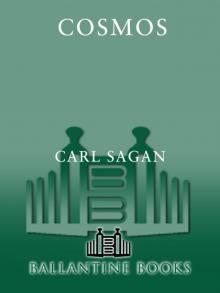 Cosmos
Cosmos Murmurs of Earth
Murmurs of Earth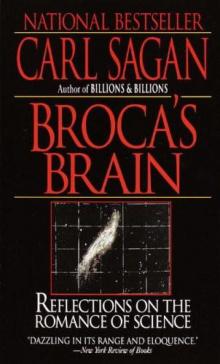 Broca's Brain
Broca's Brain Comet
Comet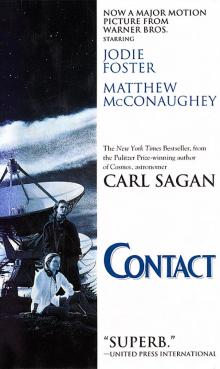 Contact
Contact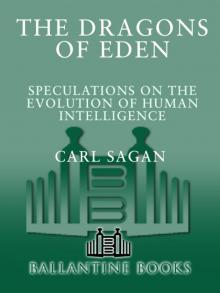 Dragons of Eden
Dragons of Eden Cosmic Connection
Cosmic Connection Shadows of Forgotten Ancestors
Shadows of Forgotten Ancestors Billions & Billions
Billions & Billions Comet, Revised
Comet, Revised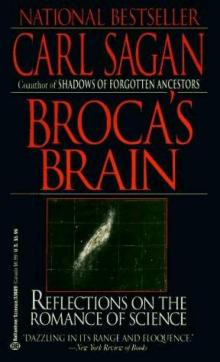 Broca's Brain: The Romance of Science
Broca's Brain: The Romance of Science The Varieties of Scientific Experience: A Personal View of the Search for God
The Varieties of Scientific Experience: A Personal View of the Search for God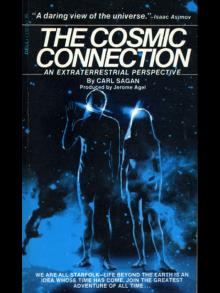 The Cosmic Connection
The Cosmic Connection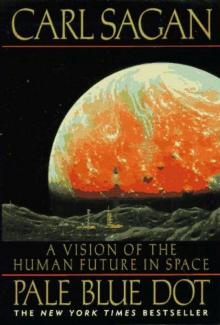 Pale Blue Dot: A Vision of the Human Future in Space
Pale Blue Dot: A Vision of the Human Future in Space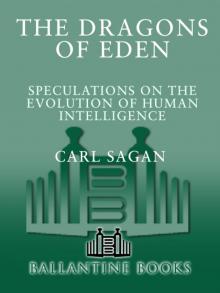 The Dragons of Eden
The Dragons of Eden